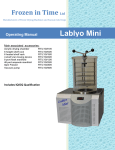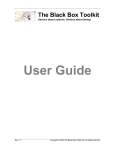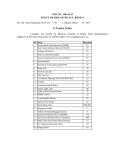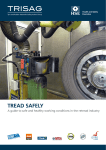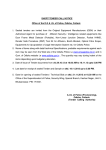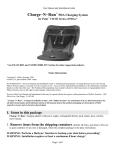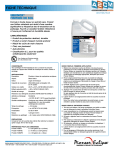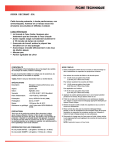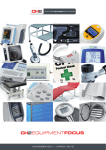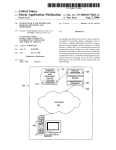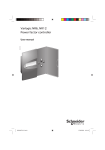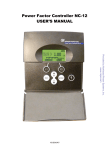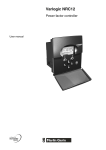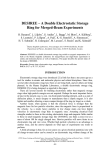Download User Manual - Envirostar
Transcript
Envirostar Model ES10 Operating, Maintenance and Spares Manual. Envirostar Limited PO Box27 Sheriff Hutton York YO60 6WZ Phone: 08450 066099 E-mail: info@envirostar. co.uk www.envirostar.co.uk General information statement ENVIROSTAR LTD has a policy of continuous product improvement and reserves the right to modify and amend the specification and content of the ENVIROSTAR. The name and logo ENVIROSTAR ™ are registered trademarks. The name ENVIROSTAR© is copyright and belongs to ENVIROSTAR LTD. Patents are currently pending on the ENVIROSTAR models. Information on the Briggs and Stratton engine is reproduced by the kind permission of Briggs and Stratton U.K. Information contained in this manual is the property of ENVIROSTAR LTD and is not to be reproduced without prior permission. For further information about ENVIROSTAR products please call your local dealer or contact ENVIROSTAR direct: Telephone number: 08450 066 099 E mail: [email protected] Website: WWW.ENVIROSTAR.CO.UK -2- THE ENVIROSTAR MULTI-FUNCTION MACHINE. Contents: 1. SAFETY NOTICES & ADVISE ON SAFE USE OF MACHINE 2. CE CONFORMANCE STATEMENT. 3. ENVIRONMENTAL PROTECTION. 4. GENERAL DESCRIPTION OF FEATURES. 5. LAYOUT OF MAIN FEATURES. 6. USING 6.1. 6.2. 6.3. 6.4. 6.5. 6.6. 6.7. 6.8. 6.9. 6.10. 6.11. THE ENVIROSTAR. General Precautions Fuelling, Starting & Stopping the engine Vacuum Hose Assembly Blower Hose Assembly Chipper Chute Swan Neck Output Chute The Bagger The Pressure Washer The Generator Tool Carrier Tray Hose Carrier 7. ENGINE. 7.1. Description 7.2. Engine Diagram 7.3. Storage -3- 8. MAINTENANCE. 8.1. Service schedule 8.2. Engine Adjustments 8.3. Oil Change 8.4. Air Filter Change 8.5. Spark Plug Change 8.6. Removing the covers 8.7. Fan/Chipper Drive Belts: Adjust & Replacement 8.8. Washer Pump Drive Belt: Adjust & Replacement 8.9. Alternator Drive Belt: Adjust & Replacement 8.10. Replacing Access Door Micro switches 8.11. Replacing Emergency Stop Switch 8.12. safety Circuit Schematic 8.13. Replacing Access Door Springs 8.14. Chipper Blade Replacement 8.15. Greasing the Bearings 8.16. Trailer 9. TROUBLESHOOTING. -4- 1: SAFETY The following symbols are used on the ENVIROSTAR and within this manual: The safety alert symbol is used to identify safety information about hazards that can result in personal injury. DANGER Indicates a hazard which, if not avoided, will result in death or serious injury WARNING Indicates a hazard which, if not avoided, will result in death or serious injury. CAUTION Indicates a hazard, which, if not avoided, might result in minor, or moderate injury Flammable Material and High Temperatures are present in the form of fuel and exhaust gases Biological hazard may be present in those tools and assemblies that are involved in the movement of waste. High voltage is present in the engine ignition circuits and the generator -5- Ear protection must be worn. Face protection must be worn. Safety boots must be worn. Safety gloves must be worn. Eye protection must be worn. Caution possibility of entrapment exists inside the power unit. No naked lights or smoking when fuelling the engine or the burner. Environmental Parameters for ES10. Minimum Operating Temperature: Minus 100 C Maximum Operating Temperature: + 400 C Humidity range: 25 – 85% RH Note Minimum Operating Temperature when using the pressure washer: + 40 C Storage Minimum Temperature: Minus 250 C Maximum Temperature: + 450 C Humidity Range: 20 – 95% RH -6- SAFE USE OF THE ENVIROSTAR General Machine Use Hazards: Rotating machine parts Flying debris Noise Electricity Vibration General Please read the operating instructions carefully before using the machine for the first time. Observe all safety information while operating the machine. Make sure that - you are familiar with all safety information. all users of the machine have been made aware of and understand the safety information Use of the ENVIROSTAR should be restricted to authorised persons who have been briefed on the safe use of the machine based on the user manual, these notes and assessments of the specific work tasks, which are to be carried out. (Note that the user manual should be carefully consulted before use of the machine and in relation to any maintenance work - the manual highlights specific hazards, which are not discussed in this general safety guide.) Children should not operate this machine. Young persons, as defined by 94/33/EC, should be supervised. Young persons should have their proposed scope of work made the subject to an individual risk assessment. Careful thought should be given where young people are to use the machine or where lone working is involved. Before commencing operations with the ENVIROSTAR ensure that the proposed work site is clear of all spectators, livestock and pets, that the unit is securely located, that the transport trailers wheels are chocked and that all necessary personal protection equipment is being worn by all personnel involved in the operations. -7- Before use the machine should be subject to a visual inspection by the operator to ensure that all guards are in place, all fastenings are secure, that hoses and ancillaries do not contain any residual debris from previous work and that there are no signs of blockages or of fuel or oil spills. Where the machine is trailer mounted and is to be towed to the workplace, normal road user checks of tyres, lights and security of the trailer and any ancillaries or tools carried on it should be completed before moving off. Where it is mounted or carried on some other equipment it should be checked for security and to ensure that the load conforms to road transport regulations before being taken onto public roads. When operating the ENVIROSTAR the power unit should always be within the view of the operator, who should periodically monitor that the power unit remains in a safe and stable position. Do not leave the machine unattended with the engine running. In most if not all modes of use, ear protection should be provided for operators and eye protection will be needed where there is any risk from flying debris. Footwear should be chosen to minimise risks of slipping and to provide suitable protection to the operator’s feet (circumstances will vary with specific work tasks). Do not operate the power unit in a confined space or any area where exhaust fumes may build up No adjustments or repairs are to undertaken whilst the engine is running. Only spares authorised by ENVIROSTAR Ltd should be used in the repair or servicing of the ENVIROSTAR, the use of un-authorised parts will render any warranty claims void. All input ducts, input piping and output ducts are to be fitted and secured before the engine is started. All moving parts on the equipment are guarded and the engine is automatically cut out when guards are opened. The equipment should never be used when any of the safety devices are inoperative. Despite the safeguards operative should never attempt to reach inside any part of the equipment without turning off the engine and removing the key. Operators should avoid wearing loose clothing such as ties, scarves etc. -8- The Place of Work When used at a static works site ENVIROSTAR should always be positioned on firm level ground and should be chocked or made secure in some other way to avoid movement as a result of vibration or other cause. Where the machine is mounted on some other equipment (rather than on its own trailer similar precautions will be needed to ensure stability and to avoid unwanted movement during use. The machine should always be sited so that the output duct is directed into a safe area (which is clear of workers, members of the public or materials which might be damaged by flying debris). Where there is any doubt that this area can be kept clear the need for signs or barriers should be considered. The engine should only be run in well-ventilated areas - normally outdoors. Similar precautions may be needed to keep people clear of areas in which hoses are being used (whether for blowing, vacuuming or washing). Ancillary tools should never be used close to other individuals nor should they ever be pointed at them. If hoses or the output duct become blocked or appear to be blocked the machine MUST be switched off before any attempt is made to inspect or clear any part of the equipment. Before beginning work a general inspection should be undertaken of any areas of proposed blowing or vacuuming work for any unexpected materials, such as metal fragments, glass, stones etc. ENVIROSTAR will blow or vacuum most materials of this type but risks from flying debris will be increased and additional precautions may be needed. The potential effect of noise and dust on others working or passing nearby should be carefully considered. Any spare fuel or oils, which are taken to work sites, should be carefully stored well away from heat or ignition sources and with smoking prohibited in such areas. Where ENVIROSTAR is to be refuelled it should be switched off and allowed to cool for a few minutes before the cap is removed from any fuel container and fuel is poured. 9 Use of the Vacuum Specific hazards Fire Hazard Do not use the vacuum to collect materials that are on fire or smouldering embers/ashes, etc as this may cause fire in the machine or the collection receptacle. Ensure that the collection receptacle is sufficiently robust to cope with any potential puncture hazard, which may be associated with the material, which it is proposed to collect. It is essential that sufficient air is allowed to access the vacuum pickup head in order that maximum efficiency is maintained. Do not attempt to use the vacuum on loose gravel or on liquids. Work involving animal waste/Biological Contaminants Specific Hazards Biological Hazards Where the equipment is used in the disposal of animal or other waste which may pose biological hazards specific assessments should be undertaken and methods of work devised to ensure the safety not only of those undertaking this work but of others who may use, inspect or maintain the equipment. 10 Use of the Blower Specific Hazards Wear Eye Protection Flying Debris When blowing material always wear Eye protection Ensure that all personnel are at least 15m from the operations Use of the Bagger Specific Hazards Sharp Objects Use the appropriate filter to ensure that dust hazards are kept within acceptable limits. If using the ENVIROSTAR to pick up glass, cans rubbish or similar materials, exercise extra caution when changing or handling the bag as sharp objects may penetrate the bag. Do not overfill the bag as the filter assembly and the output duct may become clogged. When handling heavy bags, ensure that the correct lifting technique is used. If in doubt get help before attempting to lift bags and if necessary consider using mechanical lifting aids. 11 Use of the Chipper Specific Hazards Machine Blockages Wear Eye Protection Hazardous substances Vibration Wear Hand Protection Flying Debris Wear Ear Protection Some plant material may be poisonous or may cause skin or eye irritation. Checks may be needed before work begins. It is suggested that skin is kept fully covered, eye protection is used and that suitable gloves are used to protect the hands during this work. The chipper input chute has been designed to minimise the risks of anyone reaching moving machine parts. Operators should however use the custom designed prodder supplied to push materials into the cutters rather than reaching into the hopper. Material leaving the output duct may travel up to 15m and is capable of causing injury. Ensure that all personnel are aware of this and keep clear of the output area and that the containment provided is capable of arresting all debris produced by the ENVIROSTAR. Anti Vibration protective gloves should be worn at all times by operators whilst feeding material into the chipper chute. 12 Use of the High Pressure Washer Specific Hazards High Pressure Wear Eye Protection Never direct the spray jet at any person or animal Never hold a finger, or any other body part, over the high-pressure nozzle Never direct the spray jet at the ENVIROSTAR itself or at any electrical equipment. After use; release the pressure in the high-pressure hose by operating the pistol trigger. Do not attempt to disconnect any hose or coupling with pressure still in the hose. When not in use disconnect the drive to the unit. Never supply any liquid other than water to the water inlet. Use only chemical cleaning agents (detergents) approved for power washing, when using the chemical injection system. Never use the chemical injection facility to introduce solvents. eg. paint thinner. Do not operate the pressure washer standing on ladders: Use a platform or scaffolding Children should not operate the pressure washer. Wear eye protection when using the pressure washer. Do not use the high pressure spray on vehicle tyre walls, which can be badly damaged by the force of water. Do not use the washer at temperatures lower than + 40 C 13 Use of the Generator Warning In common with all electrical equipment a risk of electrical shock exists when using this generator. Always check and where necessary replace power cords, plugs and equipment before attaching them to the ENVIROSTAR. Periodic inspection of the power outlet sockets and the overload breaker is recommended. A qualified electrical engineer should repair any damage immediately. Never plug the generator directly into household circuits. Always ensure that the ENVIROSTAR earthing point is connected to a suitable earth. Never operate the generator at maximum power for more than 30 minutes. When using extension cords ensure that they are suitable for outdoor use adequately rated and provide earth continuity. Do not allow the ENVIROSTAR to generate electricity if it cannot be protected from adverse weather conditions. 14 Inspection and maintenance See Section 8 for maintenance intervals and details of items requiring maintenance and inspection. Additional Inspection In addition to user checks before use (see above) routine inspections are advised to ensure that the machine and its ancillaries remain safe for use. The frequency of such inspections will vary with the nature and frequency of use of the equipment but should include: Inspection of all guards and testing of safety cut outs Inspection of top bolts securing the lifting points Inspection and testing of the emergency cut off switch Check the security and sharpness of cutting blades At not less than weekly intervals. 15 2: CE CONFORMANCE STATEMENT. For all countries; using this product is subject to the approval by the authorities concerned. The approval appears on the label affixed to the main power unit, on the Right side panel, to the left of the engine The CE marking on the product certifies compliance with technical regulations applicable at the date of approval. In accordance with the following guidelines and standards: The Machinery Directive 89/392/EEC The EMC directive 89/336/EEC The Noise Emission in the Environment by Equipment for use Outdoors Regulations. Statutory Instrument 2001: No 1701 as Amended by Statutory Instrument 2001: No 3958 16 3: ENVIRONMENTAL PROTECTION Please remember to observe the local regulations regarding the disposal of your packaging materials, exhausted batteries, oil, oil filters and other items replaced during servicing. If in doubt on the proper method of disposal please contact your local council regarding arrangements in your area. 17 4: GENERAL DESCRIPTION OF FEATURES The ENVIROSTAR multi-function unit has been designed to undertake the following tasks: Vacuuming. Blowing. Pressure Washing. Chipping. Power Generation. Mulching. Bagging. The power unit has access panels to allow fuel filling, oil level checking, starting and the connection of the various tools. Dimensions Power unit: Length - 1.2m Trailer mounted: Length - 2.3 m Width - 0.55 m Width - 1.2 m Height - 0.70 m Height - 1.1m Weight–300Kgs Weight 370Kgs Performance Vacuum 150mm Vacuum Maximum pull: 6Kg Maximum flow rate: 21 m/s Hose length: 6 m Blower Maximum flow 150mm hose: 26 m/s Chipper Maximum capacity: 65mm Maximum Chipping Rate: 20 m/s Bagger Bag size 500mm wide by 800mm long, polypropylene reinforced Easy bag and filter changing system Power Washer Pump type: Triplex plunger. Pump Maximum Pressure: 100 bars. Maximum flow: 12 L/min 18 Generator 110 or 220 Volt (factory set) 50Hz, 2.2Kva Engine specification Briggs And Stratton Single cylinder. Air-cooled. 9.1/2 Horsepower. Fuel Consumption. 3.15 L/hr at full power output. Electric start. Built in fuel gauge. Safety Features Centrally located, Emergency stop switch. (Panic button, Locking type) All entry ports are continually monitored for correct operation All moving parts fully enclosed. Transportation Trailer 600kg rated Fitted with independent suspension Road or ATV tyres & all necessary lights, wiring and plug for standard trailer socket. Tow ball attachment or garden tractor fork and pin tow hitch. 19 5: LAYOUT OF MAIN FEATURES Fork Lift Handles Generator Choke & Throttle Controls Engine Vacuum Input Access Panel Washer Pressure Gauge Engine Exhaust Pressure Washer Water Input/Output Cleaning Agent Input Maintenance Access Panel for Oil & Battery 20 Vacuum & Blower Output Panel Trailer Mounting Plate for Optional Trailed Vacuum Head Generator Frequency Meter Maintenance Access Panel 21 Lever for Pump Drive on Pressure Washer Chipper Input Access Panel Washer Pressure Adjustment Valve Emergency Stop Button Petrol Filler Cap & Gauge 22 Generator On/Off Switch 6: 6.1 6.2 6.3 6.4 6.5 6.6 6.7 6.8 6.9 6.10 6.11 6.12 USING THE ENVIROSTAR General Precautions Fuelling, Starting and Stopping the engine The 150mm Vacuum Hose assembly The 150mm Blower Hose assembly The Chipper Input Chute The Mulcher Input Chute The Output Swan Neck Chute The Bagger The Pressure Washer The Generator Tool Carrying Tray Hose Carrier 6.1 General Precautions. Warning Before commencing operations with the ENVIROSTAR ensure that the proposed work site is clear of all spectators, livestock and pets, that the unit is securely located, that the transport trailers wheels are chocked and that all necessary personal protection equipment is being worn by all personnel involved in the operations. It is recommended that certified ear, eye, hand and foot protection is worn when operating the ENVIROSTAR. When operating the ENVIROSTAR the power unit should always be within the view of the operator, who should periodically monitor that the power unit remains in a safe and stable position. Warning Do not operate the power unit in a confined space or any area where exhaust fumes may build up. Engines give off carbon monoxide, an odourless colourless poison gas. Breathing carbon monoxide can cause nausea, fainting or death. 23 Warning Do not wear loose fitting clothing or dangling items that could become caught. Warning Running engines produces heat. Engine parts, especially the exhaust, become extremely hot. Severe thermal burns can occur on contact. Combustible debris, such as leaves, grass, brush, etc. can catch fire. Allow the exhaust, engine cylinder and fins to cool before touching. Remove accumulated combustibles from the exhaust area and the cylinder area. Danger Items leaving the output duct (or hose) do so with extreme velocity and should be directed into a suitable containment, personnel should be kept clear at all times. 24 6.2 Fuelling, Starting and Stopping the engine. Warning Take care when handling petrol. Petrol is highly inflammable and the vapours that it gives off are explosive. Store petrol - in properly approved containers only - in a room to which children have no access - in a room that is protected from heat or sparks Do not refill the fuel tank in an enclosed space or while the engine is running or hot. Clean around the fuel filler cap before removing. When filling use a fine gauze funnel to ensure that the petrol is free of all foreign matter. Fill the tank to approximately 4cms (1½”) below the top of the neck to allow for fuel expansion. Be careful not to over fill. Stay away from naked flames when filling the tank and do not smoke or do anything that could generate sparks. On completion of fuelling ensure that the engine fuel tank filler cap is correctly replaced. If spillage of fuel occurs ensure that all spilt fuel is removed before continuing. Be sure spark plug, fuel cap and air cleaner are in place. Do not crank engine with spark plug removed. Recommended Fuel The engine is a four-stroke unit and requires unleaded petrol. Use clean, fresh, Lead – free petrol with a minimum 85 octane. Do not use fuels that contain Methanol Do not mix oil with the petrol 25 Recommended Oil Engines shipped from ENVIROSTAR are filled to the correct level with an appropriate grade of oil. Always check the oil level before starting the engine. Do not overfill. Use a high quality detergent oil classified “for service SF, SG, SH, SJ” or higher such as Briggs and Stratton 30W. Do not use special additives with recommended oils. Do not mix oil with petrol. Choose the SAE viscosity grade of oil from the chart that matches the starting temperature anticipated before the next oil change. Note: Synthetic oil meeting ILSAC GF-2 API certification mark and API service symbol with “SJ/CF ENERGY CONSERVING” or higher is acceptable oil for all temperatures. USE OF SYNTHETIC OIL DOES NOT ALTER REQUIRED OIL CHANGE INTERVALS. Air-cooled engines run hotter than automotive engines. The use of non-synthetic multi-viscosity oils (5W-30, 10W-30, Etc) in temperatures above 4OC (400F) will result in higher than normal oil consumption. When using a multi-viscosity oil check oil level more frequently. SAE30 oil, if used below 4oC (400F) will result in hard starting and possible engine bore damage due to inadequate lubrication. Check oil level (Approximate capacities) Model Series 85400 1154,1174,1184 138400 185400 235400 & 245400 Litres 0.6 0.7 0.9 1.2 1.5 Quarts 5/8 3/4 1 1-1/4 1-5/8 Ounces 20 24 30 41 51 Place the ENVIROSTAR on level ground, if mounted on a trailer ensure that the trailer is level, clean around the oil fill Remove the dipstick and wipe clean with a clean cloth. Insert the dipstick into the oil fill – tighten down if oil fill is High. do not tighten down if the oil level is low – remove the dipstick to check the oil level. Oil should be at the FULL mark If oil is required, add slowly. Do not over-fill. Tighten dipstick firmly before restarting the engine. 26 Starting Before starting the engine check the oil level (See above) Do not use a pressurised starting fluid. Always start, store, use and fuel the ENVIROSTAR in a level position. Before Attempting to starting the ENVIROSTAR check that the emergency stop switch has not been activated. To reset turn the switch in the direction indicated by the arrows. Also check that the access panel safety switches are being correctly activated. See section 8 for further details on the safety systems (See diagram in Section 7.2) 1. 2. 3. 4. Move the choke control (1) to the CHOKE position. Move the throttle control (2) to the FAST position. Turn the fuel shut off valve (3) to the ON position. Turn the key to the start position until the engine starts, then release, repeat if necessary. 5. When the engine is running shut off the choke and set the speed to the desired RPM for the work being undertaken. 6. If the battery has become discharged and the engine will not turn over, the engine can be started manually. 7. If engine floods, set choke to OPEN/RUN position, place throttle in FAST and crank until engine starts. Manual start 1. Proceed as above; steps 1 to 3. 2. Grasp the rope handle pull cord slowly until resistance is felt, then pull rapidly to overcome compression, prevent kickback and start the engine. 3. Repeat if necessary with the choke in the RUN position and the throttle set at FAST. 4. When the engine is running set the speed to the desired RPM for the work being undertaken. 27 Stopping 1. 2. 3. 4. 5. Do not use the choke control to stop the engine. Move the throttle to the idle / slow position. Turn the key to the OFF position. When the engine has stopped, close the fuel shut OFF valve Always remove the key from the switch when the equipment is not in use or it is left unattended. 6. When the ENVIROSTAR is transported, always close the fuel shut off valve. Caution On completion of vacuuming or chipping operations please ensure that sufficient time is allowed for all debris and materials to be cleared from the piping / ducting before shutting down the engine. Before commencing blowing or drying operations ensure that the path through the machine is clear of loose materials or debris from previous operations. 28 6.3 The 150 mm Vacuum Hose assembly Fitting the 150mm Vacuum Hose First ensure that the engine is stopped. The 150mm vacuum hose connects to the right hand side access panel, on the main power unit. The end of the hose assembly has a bar, which engages with the two (2) lugs on the right hand side access panel. Having engaged the bar into the lugs the hose assembly end fitting is moved to the right, against the spring action and this opens the access panel. The hose assembly pivots on the bar and closes across the access panel and engages in the housing, making sure that the connector is in contact with the safety switch within the housing 29 To remove the 150mm vacuum hose assembly First ensure that the engine is stopped. Move to the connector to the right; swing the left hand edge clear of the access panel opening. Carefully move the connector to the left. Disconnect the hose assembly bar from the two (2) lugs on the access panel. 30 6.4 The 150 mm Blower Hose Assembly Where conditions are unsuitable for the vacuum function, debris can be blown to a more suitable location. Fitting the 150mm Blower Hose First ensure that the engine is stopped To use the blower function, connect the 150mm hose to the outlet access panel. The 150mm Blower hose connects to the outlet access panel, on the main power unit. The end of the hose assembly has a bar, which engages with the two (2) lugs on the right hand side access panel. Having engaged the bar into the lugs the hose assembly end fitting is moved to the right, against the spring action and this opens the access panel. The hose assembly pivots on the bar and closes across the access panel and engages in the housing, making sure that the connector is in contact with the safety switch within the housing Before using the blower, ensure that all loose debris from previous vacuuming and chipping operations have cleared through the system. To remove the 150mm vacuum hose assembly First ensure that the engine is stopped. Move to the connector to the right; swing the left hand edge clear of the access panel opening. Carefully move the connector to the left. Disconnect the hose assembly bar from the two (2) lugs on the access panel. 31 6.5 The Chipper Input Chute Fitting the Chipper Input Chute First ensure that the engine is stopped. The chipper input chute fits onto the access panel on the top plate of the power unit. The duct has a bar, which engages into the two (2) lugs on the top plate access panel. The duct assembly is moved towards the right hand side of the power unit, until it is possible to engage the opposite edge of the duct into the access panel housing. The duct is held in place by the spring action of the access panel Using the Input Chipper Chute When using the ENVIROSTAR, do not wear scarves, ties or other loose items of clothing, which may become entangled. Always use anti-vibration gloves when feeding material into the chipper input chute. The chipper is capable of handling material up to 65mm diameter. Material is fed into the unit via the input duct, where it is turned into chippings & ejected from the output duct into a suitable containment. Experience will be the users best guide to the rate at which material can be processed, a useful guide to how much material the chipper can cope with is the engine revolutions, if they fall dramatically reduce the amount of material being fed in. Adjusting the engine speed control may help but permanently running the engine at maximum revolutions will reduce engine life. 32 If excessive vibration is felt when processing material through the chipper, check that the chipper blades are sharp. Materials should be pushed down the input duct using the flat end pusher supplied. Never under any circumstances push material down the chute with your hand. Do not lean over and reach into the chute. The pusher dimensions are A minimum of 500mm long The end must be at least 130mm square Minimum 130mm x 130mm Minimum 500mm 33 Removal of Chipper Input Chute First ensure that the engine is stopped. To remove the chipper input chute. Pull the duct towards the right-hand side of the power unit. Allow the end of the duct nearest the left-hand side of the power unit to rise clear of the entry access panel, then allow the duct to move towards the left-hand side of the power unit until the access panel is fully closed. Unhook the duct from the two (2) lugs on the access panel. 34 6.6 The Mulcher Input Chute Fitting the Mulcher Input Chute First ensure that the engine is stopped. The mulcher input chute fits onto the access panel on the engine side of the power unit. The duct has a bar, which engages into the two (2) lugs on the top plate access panel. The duct assembly is moved towards the right hand side of the power unit, until it is possible to engage the opposite edge of the duct into the access panel housing. The duct is held in place by the spring action of the access panel Using the Mulching Chute When using the ENVIROSTAR, do not wear scarves, ties or other loose items of clothing, which may become entangled. The mulcher is capable of handling soft pliable material. Do not feed hard materials into the chute as it will cause damage to the machine and could potentially cause injury to the operator. Material fed into the chute is is ejected from the output duct into suitable containment. Experience will be the users best guide to the rate at which material can be processed, a useful guide to how much material the mulch chute can cope with is the engine revolutions, if they fall dramatically, reduce the amount of material being fed in. Adjusting the engine speed control may help but permanently running the engine at maximum revolutions will reduce engine life. If material gets stuck in the chute, use the prodder to push the material into the machine. Materials should be pushed down the input duct using the flat end pusher supplied. Never under any circumstances push material down the chute with your hand. Do not lean over and reach into the chute. 35 Removal of Mulch Input Chute First ensure that the engine is stopped. To remove the cMulch input chute. Pull the duct towards the right-hand side of the power unit. Allow the end of the duct nearest the left-hand side of the power unit to rise clear of the entry access panel, then allow the duct to move towards the left-hand side of the power unit until the access panel is fully closed. Unhook the duct from the two (2) lugs on the access panel. 36 6.7 The Output Swan Neck Chute Caution Material leaving the output duct may travel up to 15 Metres and is capable of causing injury, ensure that all personnel are aware of this and keep clear of the output area and that the containment provided is capable of arresting all debris produced by the ENVIROSTAR Fitting the Output Swan Neck Chute First ensure that the engine is stopped. The output chute mounts onto the front of the power unit. The end of the chute has a bar, which engages with the two (2) lugs on the right hand side access panel. Having engaged the bar into the lugs the hose assembly end fitting is moved to the right, against the spring action and this opens the access panel. The chute pivots on the bar and closes across the access panel and engages in the housing, making sure that the connector is in contact with the safety switch within the housing 37 Positioning the Output Chute The output of the chute can be directed downwards by adjusting the direction quadrant. Loosen the wing nut on the direction quadrant, adjust to the desired position then retighten the wing nut to prevent movement during operation. The direction quadrant can be removed and re-positioned to direct the output sideways Removing the Output Chute First ensure that the engine is stopped. Move to the chute to the right; swing the left hand edge clear of the access panel opening. Carefully move the chute to the left. Disconnect the chute bar from the two (2) lugs on the access panel. . 38 6.8 The Bagger Fitting the Bagger First ensure that the engine is stopped. The bagging unit attaches to the front access panel of the power unit The end of the bagger connector has a bar, which engages with the two (2) lugs on the right hand side access panel. Having engaged the bar into the lugs the bagger connector is moved to the right, against the spring action and this opens the access panel. The connector pivots on the bar and closes across the access panel and engages in the housing, making sure that the connector is in contact with the safety switch within the housing The ENVIROSTAR must not be operated with the Bagger in place but without both an Air Filter and Bag fitted. Once the bagger attachment is in position a bag can be attached: Open the lower over-lever buckle insert the open end of the bag between the securing strap and the body of the bagger, closing the buckle secures the bag in position. Do not change bags with the engine running. Retaining Strap for bagge Removable bagger support 39 The bagger has been designed to operate with bags 500mm wide by 800mm long. (The measurements are taken with a bag laid on flat surface) the bag is made from reinforced polypropylene) and are widely available from agricultural merchants. In the event that these are not available locally, supplies can be obtained via ENVIROSTAR. A removable metal support is also provided, which simply hooks over the trailer tow bar beneath the bagger position. Care should be taken if the ENVIROSTAR is moved whilst this support is in place to avoid it catching on the floor and causing damage. Removing the Bagger First ensure that the engine is stopped. Move to the bagger connector to the right; swing the left hand edge clear of the access panel opening. Carefully move the bagger to the left. Disconnect the connector bar from the two (2) lugs on the access panel. Air Filter The air filter is fitted and retained in the same manner as the bag Air Filter Retaining Strap for Filter 40 6.9 The Pressure Washer The pressure washer consists of a high-pressure pump mounted inside the main power unit. The connections for water input, highpressure output and detergent input are all made using conventional quick disconnects. Provision is made to adjust the washing pressure. Safety precautions Never direct the spray jet at any person or animal. Never hold a finger, or any other body part, over the high-pressure nozzle. Never direct the spray jet at the machine itself or at any electrical equipment. After use; release the pressure in the high-pressure hose by operating the pistol trigger. When not in use disconnect the drive to the unit. Never supply any liquid other than water to the water inlet. Use only chemical cleaning agents (detergents) approved for power washing, when using the chemical injection system. Never use the chemical injection facility to introduce solvents e.g. paint thinners, petrol or oil. Do not attempt to disconnect any hose or coupling with pressure still in the hose. Do not operate the pressure washer standing on ladders: Use a platform tower or scaffolding. Children should not operate the pressure washer. Wear eye protection when using the pressure washer. Do not use the high pressure spray on vehicle tyre walls, which can be badly damaged by the force of water. Do not use the pressure washer at temperatures lower than + 40C On no account must the pump be run dry for longer than a few seconds. The ENVIROSTAR pressure washer pump is self-priming and can be connected to a mains water supply tap or to a suitable reservoir e.g. a tank or bowser. Although self priming it has been found that having the water source slightly higher than the input on the ENVIROSTAR, allows quicker starting and reduces wear in the water pump. The detergent input is also self-priming. NB Turn OFF black lance knob to use additive. 41 Connecting to the pressure washer First ensure that the engine is stopped. Connect the input hose to the input quick connect; ensure an adequate water supply is provided then connect the output hose to the output quick connect. Output Hose connected to Lance Pressure Gauge Detergent Input Hose Covers for Hose connection Point when not in Use Input Hose from Water Supply Detergent/Additive Input If required connect the detergent input. The black adjustment knob on the end of the lance must be turned OFF in order for the detergent pump to be engaged. Turn it back ON when full washing pressure is required. 42 Start the engine and engage the pump drive with the lever located on top of the main power unit.. Wait a few seconds for the pump to prime then use the pressure adjuster in conjunction with the pressure gauge to set the washing pressure. Pull the trigger on the lance to commence washing. Disconnecting the pressure washer First ensure that the engine is stopped. Pull the trigger on the lance to release the pressure. Disconnect the hoses and replace the covers over the valves. Disengage the pump drive with the lever on top of the main power unit. 43 6.10 The Generator Warning: In common with all electrical equipment a risk of electrical shock exists when using this generator. Always check and where necessary replace defective power cords, plugs and equipment before attaching them to the Envirostar. Periodic inspection of the power outlet socket(s) and the overload breaker is recommended. A qualified electrical engineer should repair any damage immediately. The generator produces 115 or 230-volt. The output voltage is factory set. The supply frequency is 50 hertz. The power available is 2.2KVA Never plug the generator directly into household circuits. Always ensure that the Envirostar earthing point is connected to a suitable earth. Never operate the generator at maximum power for more than 30 minutes. Using the generator Connect the appliance to the correct socket (Either 115 or 230 volts) Ensure the rocker switch located above the sockets within the generator housing is switched to the correct setting, either 115 or 230v. Turn the alternator On / Off switch located on the top of the main power unit, to On Adjust the engine speed to until 50Hz is indicated on the frequency meter. N.B. The speed may need to be adjusted once load is being drawn from the alternator. Test that the appliance operates. 44 If the appliance is drawing excessive current the overload trip will operate. If this is happening check that the power rating of the appliance is within the supply limits of the alternator. If the appliance is within the alternators capacity and the overload trip is still being automatically turned Off when the appliance is operated contact qualified electrical engineer and have the equipment tested. When electrical power is no longer required turn the On / Off switch, on top of the main power unit, to Off and remove the electrical plug(s) from the socket(s). Generator Housing and Electrical Outlet Frequency Meter Toggle switch to alternate between 115/230v supply 115v Socket Overload Trip Buttons 230v Socket 45 6.11 Tool Carrying Tray Attachment and use of the tool-carrying tray Caution: The attachment hooks could cause injury to the hand if care is not exercised. Wear appropriate protective gloves. The tool-carrying tray allows various tools to be carried whilst in transit between work sites. Typically the chipper input and output chute The galvanised steel structure is located onto the forward brace bar of the power unit using the open hooks. The unit is lowered in to position on the top of the power unit and secured using the strap provided. The tools that are placed on the tray should be secured using bungee straps or similar restraints. Tool Carrying Tray 46 6.12 Hose Carrier Attachment and use of the hose carrier tray Caution: The attachment hooks could cause injury to the hand if care is not exercised. Wear appropriate protective gloves The hose carrier tray allows the 150mm vacuum hose to remain attached to the power unit whilst in transit between work sites. It is not suitable for use on roadways. The galvanised steel structure is located onto the rear brace bar of the power unit using the open hooks. The unit is lowered in to position on the top of the power unit and secured using the strap provided. The 150mm hose is connected to the input duct. Starting at the front of the power unit, the hose is laid across the top to the rear a loop is then formed at the rear of the power unit, the lowest part of the loop should not be lower than the rear member of the trailer, the hose is then returned to the front of the power unit. Hose Carrier loaded with 150mm wander hose Hose Carrier Tray unladen 47 7: THE ENGINE 7.1 7.2 7.3 Description Engine diagram Storage 7.1 Description The engine is a Briggs & Stratton, 9 H.P. single cylinder, air-cooled, petrol engine model type 185400 (for exact model see the engines identification plate) it is fitted with both electric and manual pull start. 7.2 1 2 3 4 5 6 7 Engine diagram Fuel shut off. Rope handle. Air cleaner. Engine: Model, Type, Code. Throttle and choke controls. Fuel filler. 8 9 10 11 12 13 14 48 Blower Housing Oil Drain plug Exhaust guard / Exhaust Carburettor Spark plug Lead Oil filler / Dipstick 12 Volt Electric Starter 7.3 Storage Engines stored over 30 days need to be protected or drained of fuel to prevent gum from forming in the fuel system or on essential carburettor parts. For engine protection we recommend the use of Briggs and Stratton Fuel Stabiliser available from authorised Briggs and Stratton service dealers or from ENVIROSTAR. Mix stabiliser with the fuel in the fuel tank or fuel storage container. Run the engine for a short time to circulate the stabiliser through the carburettor. The engine and treated fuel can now be safely stored for up to 24 months. Note: If the fuel stabiliser is not used or the engine is operating on petrol containing alcohol EG Gasohol, remove all the fuel from the tank and run the engine, until it stops due to lack of fuel. 1 Change the oil. See oil service (See figs 2, 7) 2 Remove the spark plug and pour about 15ml (1/2 oz) of clean engine oil into the cylinder. Replace the spark plug and crank slowly to distribute the oil 3 Clean chaff and debris from the cylinder and cylinder head fins, under the finger guard and behind the exhaust 4 Store in a clean, dry area, but NOT near a stove, furnace or water heater, which uses a pilot light or any device that can create a spark. 49 8: MAINTENANCE All maintenance should be carried out by suitably qualified personnel. If in any doubt about any aspect of maintaining the ENVIROSTAR please contact your authorised service agent or ENVIROSTAR LTD. Warning Running engines produces heat. Engine parts, especially the exhaust, become extremely hot. Severe thermal burns can occur on contact. Allow the exhaust, engine cylinder and fins to cool before touching. Remove accumulated combustibles from the exhaust area and the cylinder area. Warning To prevent accidental starting remove the sparking plug lead (1) and ground it before attempting adjustments. Also disconnect the Negative terminal of the battery. In all maintenance routines the engine is not to be run when the covers are removed 50 8.1 Service intervals. 8.2 Engine adjustments 8.3 Oil Change 8.4 Air Filter Change 8.5 Spark Plug Change 8.6 Removing the covers 8.7 Fan/Chipper Drive Belt: Adjustment & Replacement 8.8 Washer Pump Belt: Adjustment & Replacement 8.9 Generator Belt: Adjustment & Replacement 8.10 Replacing access door micro switches 8.11 Replacing the emergency stop switch 8.12 Safety Circuit Schematic 8.13 Replacing access door springs 8.14 Replacing Chipper Blades 8.15 Greasing the bearings 8.16 Trailer 51 8.1 Service intervals. The ENVIROSTAR should be serviced in accordance with the following table More frequent service is required when operating in adverse conditions. After the first 5 hours of operation change the Oil. Daily Check the oil level. Test the access panel door switches & Emergency stop switch. Check for any accumulation of combustible materials inside the case or around the exhaust. Check engine linkages for debris. Check the trailer tyre pressures (see 8.12) Weekly or every 25 operating hours Daily routine plus. In high ambient temperatures change the engine oil. Service the engine air pre-cleaner. Grease the main shaft bearings Check that the chipper blades are sharp, change as necessary Monthly or every 50 operating hours Weekly routine plus. Change the engine oil. Clean the fuel filter. If fitted clean and inspect the spark arrestor. Check the tension of the drive “V” belts. (Fan chopper & washer drive & Alternator) Check the operation of all access panel doors and grease the slides. Check the security of all hose attachments. 52 3 monthly or every 100 operating hours Monthly routine plus. Service the air cleaner cartridge. Replace the spark plug. Clean the fuel filter. Clean the engine cooling system. Check the “L” frame for signs of damage. Check the transport trailer for damage to the frame and tyres. Touch up damaged paint Check the lid bolts are grade 8.8. Annually 3 monthly routines plus. Check the engine valve clearances. Check all side panel bolts are secure. 8.2 Engine Adjustments Throttle control adjustments (See Diagram in 7.2) Manual friction throttle control: If adjustment is required, loosen or tighten locknut until the throttle control moves easily, but stays set in position. Fixed governor control The adjustable governor control has been set for the ENVIROSTAR and should not be adjusted with out our permission. Carburettor adjustment Caution The maximum speed of the engine has been set by ENVIROSTAR and should not be exceeded please contact us before attempting any adjustments 53 8.3 Oil Change (See Diagram in Section 7.2) Check the oil level regularly. Be sure that the oil level is maintained. Check daily before starting the engine and every 8 hours of operating. Caution Oil products can cause skin conditions wear protective gloves Change the oil at the intervals specified in the Maintenance Schedule. To change the oil remove the oil filler / dip stick assembly. Ensure that a suitable tray is positioned to catch the oil. Remove the oil drain plug and allow the oil to drain. When draining is completed replace the drain plug. Refill with the correct oil type (see section 6.2) After refilling, allow the oil to settle and recheck the level Caution Dispose of used oil correctly DO NOT put into a surface water draining system or burn, contact your local council for advice on disposal. 54 8.4 Air Filter Change (see diagram in 7.2) Caution Oil products can cause skin conditions wear protective gloves Replace the pre air cleaner and or cartridge if very dirty or damaged. Loosen screws, remove the cover and air cleaner assembly from base. Remove the cartridge (retainer 4, if equipped) and pre-cleaner. To service pre-cleaner, wash in liquid detergent and water. Squeeze dry in a clean cloth. Saturate in clean engine oil. Squeeze in clean, absorbent cloth to remove ALL EXCESS oil. To service the cartridge, clean by tapping gently on a flat surface. Warning DO NOT use petrol or petroleum based solvents, these will cause the cartridge to deteriorate. DO NOT use pressurised air as this can damage the cartridge. DO NOT oil the cartridge. Reinstall pre-cleaner on retainer. Install pre-cleaner in the cover with the mesh side towards the cartridge, install the cartridge in the cover or onto the base. Seat the cover and air cleaner assembly squarely onto the base (locate tabs into slots ) Tighten the cover screws securely. 55 8.5 Spark Plug Change (see diagram in 7.2) Warning DO NOT check for a spark with spark plug removed. Use a spark tester , to check for spark. DO NOT crank engine with the spark plug removed. If the engine is flooded, place the throttle in FAST and crank until engine starts. Spark plug gap should be 0.76mm of 0.030 inches. Replace the spark plug every 100 hours or every season, which ever occurs first. If a suppression resistor is fitted in the ignition lead, ensure that any replacement contains the same arrangement. Keep engine clean Periodically remove chaff and debris build up from the ENVIROSTAR and the engine. Do not spray the engine with water to clean it as water may contaminate fuel. Clean using a hand brush or compressed air. To assure smooth operation, keep the governor linkage, springs and controls free of debris. Accumulation of debris around the exhaust could cause a fire. Inspect before every use. If the exhaust is fitted with a spark arrester remove the spark arrester screen for cleaning and inspection every 50 hours or every season. Replace if damaged. Clean the engine cooling system of all chaff and debris especially after prolonged operations. Internal cooling fins and surfaces may require cleaning to prevent over heating and engine damage. Remove the blower housing and clean as shown 56 8.6 Removing the covers. The top cover is secured to the side panels by 12 off M10 grade 12.9cap head bolts. The bolt grade is important to the safe handling of the main power unit as they not only secure the lid but also retain the lifting points. If any of these bolts becomes damaged or is lost it must be replaced with one of the same grade. Use an 8mm AF Allan key to remove the 12 bolts and washers. Remove the fork pocket mounting brackets. Lift the cover carefully to avoid damaging the emergency stop switch. Replacement is a reversal of the above procedure. After replacing the lid test the emergency stop. To remove the Right or Left hand side cover. Remove the top cover. Remove the two joining bolts in the front and rear panels Remove the seven bolts from the chassis plate (Lower edge) Remove the two bolts from each handle. The panel can now be removed. To refit reverse the procedure. To remove the rear cover. Remove the top cover. Remove the four-side plate joining bolts. Remove the three chassis bolts. Do Not remove the engine positioning bolt. Carefully pull the panel away from the power unit. Remove the supply and return diesel fuel pipes from their connectors. The panel can now be removed. To remove the front cover. Remove the top cover. Remove the four side plate joining bolts. Remove the three chassis bolts. The panel can now be removed. Case bolts should be tightened to 60 – 65 Nm with the exception of the bolts which retain the rubber bumper strips these should only be tightened to a torque of 30Nm Maximum. Case bolts which also retain the fork lift pocket lift points should be tightened to a torque of 65 –70Nm 57 8.7 Chipper/Fan Drive Belts: Adjustment & Replacement First remove the top cover. Loosen the engine mounting bolts, and move the engine towards the fan / chopper assembly by turning the positioning / tension adjustor, located at the lower edge of the mounting plate. This will allow damaged belts to be removed from the driving pulley. Remove the fan / chopper assembly, shaft bearing by removing the two (2) bolts retaining the bearing to the bearing spacer, release the bearing to shaft retention and sliding the bearing off the shaft. It will now be possible to remove the “V” belt(s). Inspect both the driving and driven pulley for damage. Install the new “V” belt(s) onto both pulleys. Replace the bearing onto the fan / chopper assembly shaft. Replace the two (2) bearing retention bolts and tighten. To a torque of 80Nm Tighten the bearing to shaft retention. Adjust the belt tension engine, until the free movement at the mid point on the “V” belts is between 8 & 10 mm. Tighten the engine retaining bolts. To a torque of 40 – 45Nm Check that the belts are aligned correctly with the pulleys by observing their motion whilst carefully turning the engine over by hand. It may be necessary to remove the sparking plug(s) to allow the engine to be rotated by hand. Caution Great care is required when turning the belts; as the guard assembly is removed and there is an increase risk of entrapment in the belt assembly. 58 Once the correct alignment and belt tension has been achieved. Check of all fastening torques. Replace the engines sparking plug. Refit the top cover. Test run the unit. 59 8.8 Washer Pump Drive Belts: Adjustment & Replacement First remove the top and right hand covers. Ensure the pump on / off lever is in the OFF position. Loosen the bolts securing the belt guides and move the guides clear Remove the belt. Check the condition of the pulleys Fit the new belt. Reposition the belt guides Move the drive on / off to ON and check the tension of the belt. Check that the belts are aligned correctly with the pulleys by observing their motion whilst carefully turning the engine over by hand. It may be necessary to remove the sparking plug(s) to allow the engine to be rotated by hand. Caution Great care is required when turning the belts; as the guard assembly is removed, there is an increase risk of entrapment in the belt assembly. Replace the covers. Test the emergency stop Test run the pump. Belt guide Belt Guide ON / OFF lever 60 8.9 Generator Drive Belt: Adjustment & Replacement The alternator is driven from the main shaft by a single “V” belt To replace the belt, Remove the side access panel then remove the six hex head set screws, which retain the alternator cover, then remove the cover from the main casing. Care should be exercised when removing the cover, as the electrical wiring for the outlet and circuit breaker, fitted to the end plate of the alternator cover, remain attached to the alternator. Cover Bolts Loosen the four bolts, which retain in the alternator to the mounting tray and slide the alternator assembly towards the main shaft until the belt can be removed from the drive pulley. Retention bolts Inspect the condition of the drive and driven pulleys before fitting the new belt. 61 Adjust the belt tension by moving the alternator tray away from the drive shaft The correct free play is +/- 3mm When tensioned correctly tighten the retention bolts to a torque of 40 – 50Nm Refit the alternator cover and cover bolts; check that the trailing wires are not trapped under any part of the cover and have not moved into a position that will bring them into contact with any moving part. Refit the side access panel Test run the unit. 62 Caution It is recommended that the following safety related items are only replaced and adjusted by an authorised ENVIROSTAR agent. 8.10 Replacing the access door micro switches Remove the top cover. The switches are located at the extremity of the access door travel. Disconnect the Grey & Black wire from the connector block on the fan casing Remove and retain the 2 screws, washers & nuts Fit the new switch using the 2 screws, washers & nuts (Do not over tighten as this can cause the switch to seize) The switch action has an audible click when operated. Connect the wires to the connector block. The switch action can be monitored by connecting a multi meter, set on resistance, across the Grey and Black wires. Moving the access panel towards the open position by approximately 2mm should activate the micro switch. The switch is short circuit when the door is open. Check that when the door is released the springs cause the door to shut and the short circuit is removed by switch activation. If the access door does not fully close investigate the cause and rectify. See section 8.12 Replace the top cover. 63 8.11 Replacing the emergency stop switch Remove the top cover. The emergency stop switch is mounted on a bracket. To remove the switch, disconnect the two wires. Pull the “U” clip (Between the switch and the body) until the clip is approximately 6mm long The switch can now be pulled clear of the actuator. Push the new switch into position and return the “U” clip to its original position. Check that the switch is secured to the actuator. Replace the wires. Check that the circuit is functioning with a multi meter. Stop = short circuit. Run = Open circuit. To fit a new actuator; Remove the switch as per above Loosen the bezel & remove the bezel ring. Extract the actuator body. Fit the new actuator and bezel ring. Refit the switch and wiring. Ensure the switch is released. Turn the switch top in the direction of the arrows. 64 8.12 Safety Circuit Schematic To Briggs & Stratton Stop switch Emergency Stop Door Switch 1 Door Switch 2 Chassis connection 65 Door Switch 3 8.13 The Access Panel Assemblies The access panels are slide mechanisms, with springs positioned to ensure positive closure. Maintenance is confined to periodic lubrication of the slides, replacement of the safety micro switches see section 8.5, and replacement off the springs. The access panel doors are not user serviceable. Please contact your agent or ENVIROSTAR direct if these items require attention. The sliding edges should be lubricated with good quality multi purpose lithium based grease such as Castrol LM. To apply, remove the top cover. Insert the service tool into the access panel to be lubricated, this exposes the sides of the slide and allows the grease to be applied. Apply sufficient grease to ensure smooth operation. Replacing the springs. Use long nosed engineers pliers to remove the spring from the spigot end. Remove the spring from the mounting location hole Fitting the spring is the reverse procedure. Check the operation of the access panel. 66 8.14 Replacing Chipper Blades Warning Two people are required to carry out this procedure. Ensure the engine has been stopped for more than 2 minutes. Remove the ignition key and disconnect the spark plug lead before attempting this procedure. Remove the four bolts from the access panel located on the left hand side of the power unit. Remove the cover. Remove the bolt (1) and washer (1) from the inner cover. Lift the inner cover clear of the fan housing. Use a service tool to hold open the output access panel. Use a ½” square drive, socket mounted, 8mm AF Allan key to hold the countersunk headed screws which retain the blade to the fan back plate. Remove the Nyloc nuts, which retain the blade Remove the blade. Place the new blade in position and replace the fastenings, tighten to a torque of 75 – 80Nm Repeat for the second blade. Refit the inner cover Refit the access panel Remove the service tool from the output access panel. Test the safety switches. Test run the unit. 8.9 Greasing the bearings. 8.15 Greasing the Bearings The main fan / chipper shaft has two bearings both of which should be lubricated with good quality multi purpose lithium based grease such as Castrol LM. 67 Remove the four bolts from the access panel located on the left hand side of the power unit Remove the cover Locate the bearings grease points (2) Using a grease gun, pump in grease. If regular servicing has been conducted, only one or two repetitions should be required. Replace the covers. 68 8.16 Trailer The trailer tyres should be inspected daily for wear, damage and correct inflation Tyre Pressures. Wide Road Tyre Narrow Road Tyre ATV Tyre 2.5Kg/cm2 35 P.S.I. 2.5Kg/cm2 35 P.S.I. 0.7Kg/cm2 10 P.S.I. 69 9: TROUBLESHOOTING Before commencing any work on the machine: - switch off the engine - wait until all moving parts have come to a standstill - pull off the connector on the spark plug so that it is impossible for the engine to start unintentionally Problem Possible Causes Engine will not start. Fuel tank is empty or fuel is too old. Is the fuel tap turned on. Battery discharged. Is the Emergency Stop Switch activated. Are the access panel safety switches engaged. Reduction in power, engine does not run smoothly. Machine does not eject shredded or chipped material. Speed at which shredded material is ejected has reduced considerably, or vibration increased when using chipper Reduced suction in vacuum Pressure Washer does not provide full pressure Remedy Remove old fuel and fill tank with fresh clean fuel. Turn on fuel tap. Charge battery. Reset the switch. Ignition cable is not connected. Defective spark plug. Open & re-close all access panels ensuring the safety switches are properly engaged. Connect ignition cable to spark plug. Clean plug and reset gap or replace plug. If engine is cold: Choke lever not set to “CHOKE” Set choke lever to “CHOKE” Generator or power washer switches activated whilst not in use. Engine is running with choke lever set to “CHOKE”. Fuel line is blocked or fuel is too old. Water or dirt inside fuel system. Dirty air filter. Outlet chute is blocked or something is caught in vacuum unit. Collecting Bag is full. Check both switches/levers to ensure they are in the correct position for current activity. Set choke lever to “RUN”. Chipper blades are blunt. Have chipper blades sharpened or replaced. Something is stuck in vacuum hose. Pressure adjustment knob is turned down Lance adjustment k knob set to detergent setting Remove cause of blockage. 70 Clean fuel line, fill tank with fresh clean fuel. Disconnect fuel line and drain fuel tank. Fill tank with fresh fuel. Clean air filter. Remove cause of blockage. Empty collecting bag. Locate pressure adjustment knob on top of the unit, and turn it up Turn on the black adjustment knob on the end of the lance. NB this knob must be turned OFF when applying an additive, and turned back ON when full washing pressure is required






































































